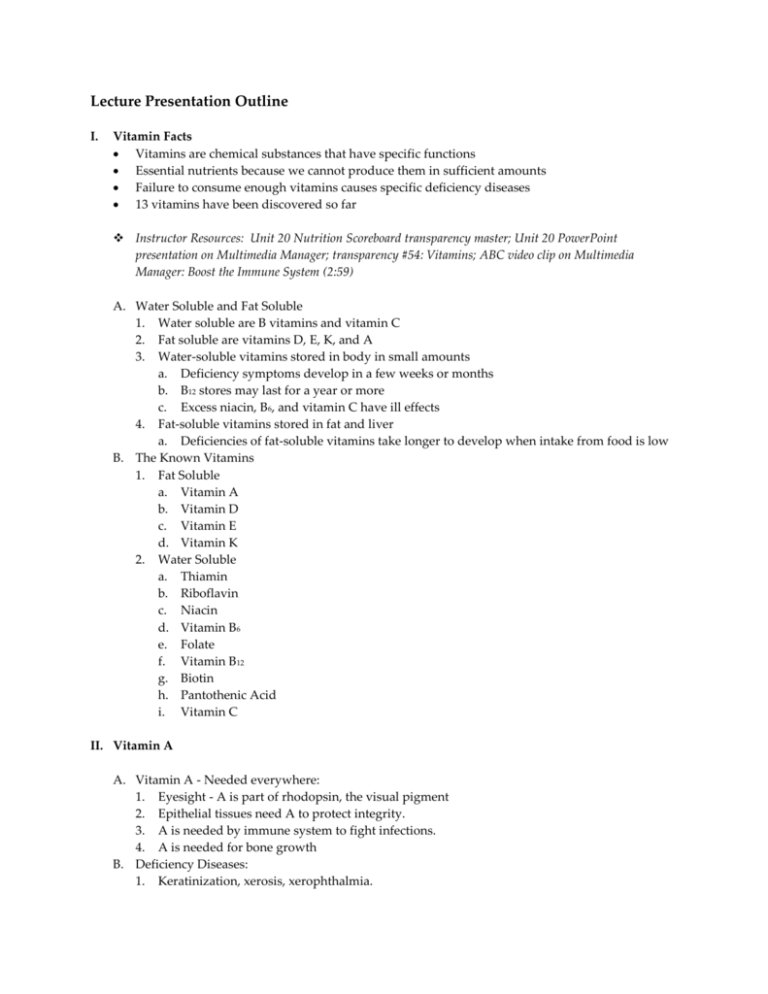Lecture Presentation Outline
advertisement

Lecture Presentation Outline I. Vitamin Facts Vitamins are chemical substances that have specific functions Essential nutrients because we cannot produce them in sufficient amounts Failure to consume enough vitamins causes specific deficiency diseases 13 vitamins have been discovered so far Instructor Resources: Unit 20 Nutrition Scoreboard transparency master; Unit 20 PowerPoint presentation on Multimedia Manager; transparency #54: Vitamins; ABC video clip on Multimedia Manager: Boost the Immune System (2:59) A. Water Soluble and Fat Soluble 1. Water soluble are B vitamins and vitamin C 2. Fat soluble are vitamins D, E, K, and A 3. Water-soluble vitamins stored in body in small amounts a. Deficiency symptoms develop in a few weeks or months b. B12 stores may last for a year or more c. Excess niacin, B6, and vitamin C have ill effects 4. Fat-soluble vitamins stored in fat and liver a. Deficiencies of fat-soluble vitamins take longer to develop when intake from food is low B. The Known Vitamins 1. Fat Soluble a. Vitamin A b. Vitamin D c. Vitamin E d. Vitamin K 2. Water Soluble a. Thiamin b. Riboflavin c. Niacin d. Vitamin B6 e. Folate f. Vitamin B12 g. Biotin h. Pantothenic Acid i. Vitamin C II. Vitamin A A. Vitamin A - Needed everywhere: 1. Eyesight - A is part of rhodopsin, the visual pigment 2. Epithelial tissues need A to protect integrity. 3. A is needed by immune system to fight infections. 4. A is needed for bone growth B. Deficiency Diseases: 1. Keratinization, xerosis, xerophthalmia. 2. Infections, weak bones, poor teeth. C. Toxicity: Hyper A vitaminosis D. Average RDA: 800 - 1000 RE/day E. Sources: ß-Carotene 1. Plant pigment, precursor of A. Converted to A. 2. Green and yellow fruits/vegetables. III. Vitamin D A. Synthesis from precursor sterols by sunlight B. Functions: 1. Bone growth 2. Helps maintain blood calcium C. Deficiency Diseases: rickets, osteomalacia (weak bones) Instructor Resources: transparency #9: Vitamin Deficiencies: Rickets and Pellagra D. Toxicity: 5 X RDA 1. symptoms of D poisoning: diarrhea, headache, nausea E. Adult RDA 5 µg/day. F. Sources: Cod liver oil, butter, cream, egg yolks, fatty fish, and sunlight IV. Vitamin E A. Antioxidant; prevents damage to PUFAs and vitamin A B. Functions: 1. Protects lung membranes. 2. May reduce risk of heart disease. 3. May help heal burns, may help prevent sunburn, may promote tan. C. Deficiency Diseases: 1. Premature babies have erythrocyte hemolysis. 2. Adults have anemia, neuromuscular disorder, fibrocystic breast disease, intermittent claudication, and malabsorption of fat. D. Toxicity: Rarely seen. Maybe free bleeding. E. Average RDA 8 - 10 mg/day. F. Sources: Widespread in plant kingdom. Wheat germ oil, fruits and veggies. V. Vitamin K A. Involved with blood clotting B. Functions: 1. Needed for synthesis of blood clotting proteins 2. Assists A in bone formation function C. Deficiency Diseases: Possibly uncontrolled bleeding Instructor Resources: transparency #57: Vitamin K Deficiency D. Toxicity: Rarely seen E. Average RDA 45 - 80 µg/day F. Sources: Dark green leafy vegetables (spinach) and liver VI. Thiamin A. Functions: 1. Energy metabolism 2. Appetite 3. Nervous system function B. Deficiency Disease: Beriberi 1. Symptoms: Weakness, pain, low morale, nervous disorders, mental confusion. C. Toxicity: None reported D. Average RDA 1.1 - 1.5 mg/day E. Sources: Meat, grains, beans, nuts. VII. Riboflavin A. Functions: 1. Energy metabolism 2. Vision 3. Skin health B. Deficiency Disease: Ariboflavinosus. 1. Symptoms: Chielosis, photophobia, skin rash, nervous disorders, and confusion. C. Toxicity: None reported D. Average RDA 1.2 - 1.8 mg/day E. Sources: Meat, milk, green vegetables, grains. VIII. Niacin A. Functions: 1. Energy metabolism 2. Skin health 3. Nervous system B. Deficiency Disease: Pellagra Instructor Resources: transparency #9: Vitamin Deficiencies: Rickets and Pellagra 1. Symptoms: Diarrhea, irritability, confusion, psychosis, skin rash C. Toxicity: 10 X RDA = "niacin flush" D. Average RDA 15 - 20 mg/day E. Sources: Meat, milk, eggs, fish, grains, high protein foods. IX. Folate A. Functions: New cell synthesis. B. Deficiency Disease: Megaloblastic anemia Instructor Resources: transparency #55: Folate Deficiency: Megaloblastic Anemia 1. Symptoms: Anemia, red tongue, nervous disorders, confusion. C. Toxicity: None reported D. Average RDA: 50 - 200 µg/day E. Sources: Beans, grains, liver. X. Vitamin B12 A. Functions: 1. New cell synthesis 2. Nerve maintenance B. Deficiency Disease: Vitamin B12 deficiency anemia 1. Symptoms: Anemia, fatigue, and paralysis. C. Toxicity: None reported D. Average RDA: 1 - 2 µg/day E. Sources: Meat, milk, fish, and poultry. XI. Vitamin B6 A. Functions: 1. Amino acid metabolism 2. Red blood cells B. Deficiency Diseases: Nameless collection of symptoms 1. Symptoms: Anemia, irritability, skin rash, nervous disorders, confusion. C. Toxicity: Depression, fatigue D. Average RDA: 1 - 2 mg/day E. Sources: Meat, milk, green vegetables, beans, grains XII. Biotin A. Functions: energy, amino acid and fat metabolism. B. Deficiency Diseases: Nameless collection of symptoms. 1. Symptoms: Abnormal heart rate, nausea, fatigue, nervous disorders, confusion. C. Toxicity: None reported D. Average RDA: 30 - 100 µg/day E. Sources: Ubiquitous. XIII. Pantothenic acid A. Functions: Energy metabolism B. Deficiency Diseases: Nameless collection of symptoms 1. Symptoms: Vomiting, insomnia, fatigue. C. Toxicity: None serious D. Average RDA: 4 - 7 mg/day E. Sources: Ubiquitous. XIV. Vitamin C A. Functions: 1. Collagen synthesis 2. Antioxidant 3. Amino acid metabolism B. Deficiency Disease: Scurvy Instructor Resources: transparency #56: Vitamin C Deficiency: Scurvy 1. Symptoms: Anemia, bleeding gums, weakness, muscle pain, slow healing C. Toxicity: Headache, rashes D. Average RDA: 160 mg/day E. Sources: Citrus fruits, vegetables and fruits XV. Bogus Vitamins A. Substances claimed to be vitamins by quacks, supplements manufacturers and some weight-loss and cosmetic product producers B. Substances aren’t essential and cannot be considered vitamins C. People do not develop deficiency diseases from too little of these bogus vitamins XVI. What Vitamins Do A. Vitamins do not provide energy or serve as components of body tissues B. Some vitamins are coenzymes in the conversion of proteins, carbohydrates, and fats into energy C. Coenzymes are involved in reactions that build and maintain body tissues such as bone, muscle, and red blood cells 1. Thiamin is needed for reactions that convert glucose into energy 2. Folate is required for reactions that build body proteins 3. Vitamin A is needed for reactions that replace worn-out cells that line the mouth, esophagus, intestines, and eyes with new ones 4. Vitamin C required for reactions that build and maintain collagen, a protein found in skin, bones, blood vessels, gums, ligaments, and cartilage D. Vitamins affect behaviors such as: 1. Reduced attention span 2. Poor appetite 3. Irritability 4. Depression 5. Paranoia 6. Precede physical signs of deficiency E. Vitamins are “vital” for health F. Folate 1. 400 micrograms of folic acid before and in pregnancy prevents about two-thirds of cases of neural tube defects in newborns Instructor Resources: transparency #58: Spina Bifida a. b. Neural tube defects are abnormalities of the spinal cord and brain Most common type of birth defect 2. Adequate folate reduces the risk of developing heart disease 3. Blood levels of folate have doubled due to fortification 4. Neural tube defects are declining, as are blood levels of homocysteine, a risk factor for CVD G. Vitamin A 1. Adequate vitamin A decreases severity of measles and other infectious diseases 2. Adequate vitamin A prevents blindness 3. Vitamin may be a treatment for skin and cervical cancer 4. Vitamin A derivative (retinoic acid) is used in the treatment of serious cases of acne, skin wrinkles, and “liver” or “aging” spots on the skin H. Vitamin D 1. Vitamin D intake of 1000 IU per day decreases bone loss and reduces osteoporosis risk 2. Breast milk is low in vitamin D, infants on human milk need exposure to sunlight or supplements a. D deficiency infants fail to get enough sunlight b. Modest exposure to sunshine sufficient to supply required vitamin D c. In cold climates, vitamin D supplement is needed I. Antioxidant Vitamins Instructor Resources: transparency #62: Antioxidants in Colorful Foods; CNN Today Nutrition Vol. 2: Vitamins and Cancer (2:05) 1. 2. 3. 4. Beta-carotene (a precursor to vitamin A), vitamin E, and vitamin C are antioxidants They prevent or repair damage to cells caused by free radicals a. A free radical forms when hydrogen or oxygen loses an electron b. The imbalance makes the atom reactive in order to reestablish a balance between its positive and negative charges c. Atoms and molecules that have lost electrons to free radicals are said to be oxidized d. Oxidized substances are reactive and damage cell membranes, DNA, and other cell components e. Antioxidants stabilize oxidized molecules or repair them Free Radicals a. Free radicals have roles in the body b. They are always present, produced 1. During energy formation 2. By breathing 3. By the immune system c. Formed by exposure to alcohol, radiation emitted by the sun, smoke, ozone, smog, and environmental pollutants Cellular Damage a. Cellular damage from free radicals plays a role in cancer, bronchitis, emphysema, heart disease, cataracts, and premature aging b. Vitamin E associated with slowed progression of Alzheimer’s disease, reduced plaque formation in arteries, and improved circulation in people with diabetes c. Antioxidant vitamins and selenium function as antioxidants and prevent or postpone disorders by protecting cell components XVII. Getting Enough Vitamins A. Adequate amounts of vitamins obtained from variety of foods in the Food Guide Pyramid Instructor Resources: transparency #13: The USDA Food Guide Pyramid; ABC video clip on Multimedia Manager: Mineral Water (4:51); Activities 20-2: Pyramid Sources of Vitamins, 20-3: Vitamin Content of Fast Foods & 20-4: Vitamin Content of Frozen Dinners; Handout 20-1: Pyramid Sources of Vitamins and Beta-Carotene 1. 2. Fruits and vegetables are good sources of vitamins Fortified foods can increase vitamin intake Instructor Resources: Activity 20-1: Vitamin Fortification a. Fortified food consumption may increase intake too much b. Overdoses from fortified foods not reported B. Recommendations 1. Recommendations for vitamin intakes are represented by Dietary Reference Intakes, or DRIs Instructor Resources: transparency #4: The 1997-2003 DRIs 2. 3. DRIs include Recommended Dietary Allowances, Adequate Intakes, Tolerable Upper Levels of Intake These are assigned to vitamins and indicate levels of intake from foods, fortified foods, and supplements that should not be exceeded








